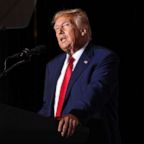First Female Airforce Pilots Get Gold Honor: 'I Never Thought It Would Happen'
Women Airforce Service Pilots of World War II get recognized after six decades.
WASHINGTON, March 10, 2010— -- When Dori Martin and Marylyn Myers Peyton joined the U.S. Air Force in the 1940s, little did they know that they would one day become a part of history.
Martin, 88, and Peyton, 86, were part of the thousand or so women who were recruited as civilian pilots in the U.S. military at the height of World War II. These Women Airforce Service Pilots -- better known as WASP -- became the first females to fly military aircraft for the U.S. armed forces.
"We never thought of ourselves as making history," Martin said.
Today, nearly 66 years after their service, the first fly girls will be awarded the Congressional gold medal.
"I never thought it would happen," Peyton said of the recognition.
"It's wonderful," Martin said. "Nobody even knew about us."
View More Photos of the Women Airforce Service Pilots
About 175 WASPs and more than 2,000 representatives of deceased WASPs attended the ceremony on Capitol Hill today to accept the Congressional gold medals, which rank with the Presidential Medal of Freedom as the highest civilian honors bestowed for courage, service and dedication.
"You gave all that you could to save the United States of America and the world that was at war," said Sen. Barbara Mikulski, D-Md., who sponsored the bipartisan legislation to grant the award.
"You fly high and into the sky," she said. "Today, instead of giving you the gun, we will give you the gold."
WASPs may have been sidelined for years, but these first female Air Force pilots had their work cut out for them. The requirements for women to become military pilots -- at least 500 hours of flying experience -- were more stringent than for men. They were paid a mere $250 per month, slightly less than men, and the women had to pay for their own lodging, food and uniforms.
Then there was the social stigma -- and the occasional jabs that came with being in a male-dominated atmosphere.
Also, unlike the men, they did not hold military rank. They were all flight officers.
But Martin and Peyton say if they had to do it all over again, they wouldn't even think twice about it.
The WASP program was launched in 1943 as the United States faced a shortage of male fighter pilots at the time when the war was at its peak.
Despite the stigma and their families' concerns, the women say all they wanted to do was fly, and the experience was a joyride.
"It was a great deal of fun and a lot of work," Martin recalled.
Peyton's journey to the group was a complicated one. She worked for United Airlines and said she wanted to learn how to fly and do something for the country during the war.
She kept hearing reports about the group, but no matter how many people she asked, she couldn't figure how to get in touch with them until one day in Wichita. She was sharing a cab with two other women who were talking about WASPs, she said. Peyton got the contact information from the women and got in touch with the women who were organizing the WASP program when she returned home to Iowa.
"It was a big secret," she said, laughing.
Getting a foot in the door was no easy task.
Of the more than 50,000 women who applied, only 1,830 were accepted and 1,074 graduated from the training program. These women were stationed at 120 army air bases around the world, and flew a total of 60 million miles. Their duties involved everything from ferrying planes to training fighter pilots to chemical missions, but they were barred from actual combat.
Both Martin and Peyton say they were treated respectfully at their base in Texas, although they heard reports of discrimination in some bases on the East coast.
However, they admit that men weren't used to them being around the base.




